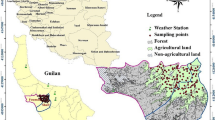Abstract
Continuous paddy rice cultivation requires fields to be flooded most of the time limiting seriously the collection of detailed soil information. So far, no appropriate soil sensor technology for identifying soil variability of flooded fields has been reported. Therefore, the primary objective was the development of a sensing system that can float, acquire and process detailed geo-referenced soil information within flooded fields. An additional objective was to determine whether the collected apparent electrical conductivity (ECa) information could be used to support soil management at a within-field level. A floating sensing system (FloSSy) was built to record ECa using the electromagnetic induction sensor EM38, which does not require physical contact with the soil. Its feasibility was tested in an alluvial paddy field of 2.7 ha located in the Brahmaputra floodplain of Bangladesh. The high-resolution (1 × 1 m) ECa data were classified into three classes using the fuzzy k-means classification method. The variation among the classes could be attributed to differences in subsoil (0.15–0.30 m below soil surface) bulk density, with the smallest ECa values representing the lowest bulk density. This effect was attributed to differences in compaction of the plough pan due to differential puddling. There was also a significant difference in rice yield among the ECa classes, with the smallest ECa values representing the lowest yield. It was concluded that the floating sensing system allowed the collection of relevant soil information, opening potential for precision agriculture practices in flooded crop fields.




Similar content being viewed by others
References
Alam, M. L., Saheed, S. M., Shinagawa, A., & Miyauchi, N. (1993). Chemical properties of general soil types of Bangladesh. Memoirs of the Faculty of Agriculture, Kagoshima University, 29, 75–87.
Brammer, H. (1981). Reconnaissance Soil Survey of Dhaka District. Revised Edition. Dhaka: Soil Resources Development Institute.
Brammer, H. (1996). The geography of the soils of Bangladesh. Dhaka: The University Press Limited.
Brevik, E. C., Fenton, T. E., & Lazari, A. (2006). Soil electrical conductivity as a function of soil water content and implications for soil mapping. Precision Agriculture, 7, 393–404.
Corwin, D. L., Lesch, S. M., & Farahani, H. J. (2008). Theoretical insight on the measurement of soil electrical conductivity. In B. J. Allred, J. J. Daniels, & M. R. Ehsani (Eds.), Handbook of agricultural geophysics (pp. 59–83). Boca Raton: CRC Press.
de Gruijter, J.J.,& McBratney, A.B. (1988). A modified fuzzy k-means method for predictive classification. In: H.H. Bock, (Ed.), Classification and related methods of data analysis (pp. 97–104). Amsterdam: Elsevier.
Ezrin, M. H., Amin, M. S. M., Anuar, A. R., & Aimrun, W. (2010). Relationship between rice yield and apparent electrical conductivity of paddy soils. American Journal of Applied Sciences, 7(1), 63–70.
Goovaerts, P. (1997). Geostatistics for natural resources evaluation. New York: Oxford University Press.
Li, Y., Shi, Z., Li, F., & Li, Hong.-Yi. (2007). Delineation of site-specific management zones using fuzzy clustering analysis in a coastal saline land. Computers and Electronics in Agriculture, 56, 174–186.
McBratney, A. B., & Moore, A. W. (1985). Application of fuzzy sets to climate classification. Agricultural and Forest Meteorology, 35, 165–185.
McNeill, J. D. (1980). Electromagnetic terrain conductivity measurement at low induction numbers. Technical Note TN-6. Missisauga: Geonics Limited.
Minasny, B., & McBratney, A. B. (2006). FuzME version 3. Australian centre for precision agriculture. Sydney: The University of Sydney.
National Instruments (2003). LabVIEW: Getting Started with LabVIEW: April 2003 edition. 11500 North Mopac Expressway Austin, Texas 78759-3504 USA.
Rhoades, J. D., Chanduvi, F., & Lesch, S. M. (1999). Soil salinity assessment: methods and interpretation of electrical conductivity measurements. (FAO irrigation and drainage paper 57). Rome: FAO.
Saey, T., Simpson, D., Vermeersch, H., Cockx, L., & Van Meirvenne, M. (2008a). Comparing the EM38DD and DUALEM-21S Sensors for Depth-to-Clay Mapping. Soil Science Society of America Journal, 73, 7–12.
Saey, T., Simpson, D., Vitharana, U. W. A., Vermeersch, H., Vermang, J., & Van Meirvenne, M. (2008b). Reconstructing the paleotopography beneath the loess cover with the aid of an electromagnetic induction sensor. Catena, 74, 58–64.
Saey, T., Van Meirvenne, M., Vermeersch, H., Ameloot, N., & Cockx, L. (2009). A pedotransfer function to evaluate the soil profile textural heterogeneity using proximally sensed apparent electrical conductivity. Geoderma, 150(3–4), 389–395.
Sheets, K. R., & Hendrickx, J. M. H. (1995). Non-invasive soil water content measurement using electromagnetic induction. Water Resource Research, 31, 2401–2409.
Simpson, D., Lehouck, A., Verdonck, L., Vermeersch, H., Van Meirvenne, M., Bourgeois, J., et al. (2009). Comparison between electromagnetic induction and fluxgate gradiometer measurements on the buried remains of a 17th century castle. Journal of Applied Geophysics, 68(2), 294–300.
Sudduth, K. A., Hummel, J. W., & Birrell, S. J. (1997). Sensors for site-specific management. In F. J. Pierce & E. J. Sadler (Eds.), The state of site-specific management for agriculture (pp. 183–210). Madison: ASA-CSSA-SSSA.
Triantafilis, J., Laslett, G. M., & McBratney, A. B. (2000). Calibrating an electromagnetic induction instrument to measure salinity in soil under irrigated cotton. Soil Science Society of America Journal, 64, 1008–1017.
Vitharana, U. W. A., Van Meirvenne, M., Simpson, D., Cockx, L., & De Baerdemaeker, J. (2008). Key soil and topographic properties to delineate potential management classes for precision agriculture in the European loess area. Geoderma, 143, 206–215.
Author information
Authors and Affiliations
Corresponding author
Rights and permissions
About this article
Cite this article
Islam, M.M., Cockx, L., Meerschman, E. et al. A floating sensing system to evaluate soil and crop variability within flooded paddy rice fields. Precision Agric 12, 850–859 (2011). https://doi.org/10.1007/s11119-011-9226-5
Published:
Issue Date:
DOI: https://doi.org/10.1007/s11119-011-9226-5




